Top 10 Famous Indian Painting Masterpieces Till 2023
Timeless Treasures: 10 Renowned Indian Paintings of Enduring Significance

While art surrounds us constantly, certain exceptional artworks have surpassed temporal and cultural boundaries to firmly establish their position in the annals of art history. These paintings have captivated art enthusiasts for years, not merely due to their aesthetic appeal, but because they contain a narrative within. Every brushstroke and every hue employed on the canvas is akin to a written word, composing a profound tale.
Also Read: Contemporary Canvas Prints Wall Art
Indian artists have also produced awe-inspiring masterpieces that have left an indelible impact on the global art scene. Presented below, in no specific sequence, is a compilation of 10 renowned Indian paintings that have earned everlasting recognition. These iconic creations from various eras are destined to be etched in our collective memory.
1. Self Portrait – Amrita Sher-Gil
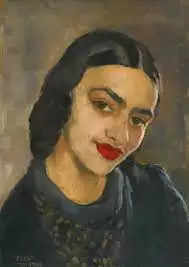
Displayed here is a self-portrait from 1931 by Amrita Sher-Gil, showcasing the esteemed Indian modern artist during her youthful years at the age of 18. Notably, this remarkable artwork marks Sher-Gil's inaugural painting to be presented at Christie's London and is among a scarce collection of only eight canvases by the artist ever offered for auction worldwide. Sher-Gil's self-portraits are characterized by an enthralling intensity that possesses an almost hypnotic quality, compelling the observer to delve into the artist's innermost psyche and unravel a profound ocean of melancholy.
2. Bharat Mata – Abanindranath Tagore
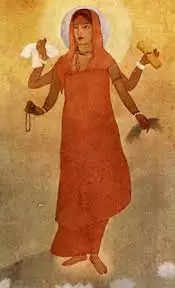
Bharat Mata, one of Abanindranath Tagore's most iconic paintings and a masterpiece from the Bengal School of Art, portrays a saffron-clad woman reminiscent of a sadhvi. She is depicted holding various symbolic items—a book, sheaves of paddy, a piece of white cloth, and a garland—each held in one of her four hands. This painting holds immense emotional and historical significance, garnering immense popularity among nationalists of that era, particularly during the period when Lord Curzon proposed the division of Bengal. Interestingly, Sister Nivedita, an admirer of the artwork, expressed her desire to transport it across the length of India, from Kashmir to Kanyakumari, with the aim of spreading the fervor of nationalism among the people of the nation.
3. Shakuntala – Raja Ravi Verma
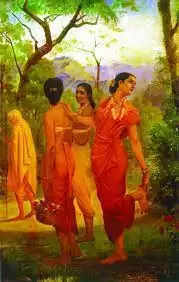
Shakuntala, a renowned painting by the celebrated Indian artist Raja Ravi Varma, captures a pivotal moment from the epic Mahabharata. In the artwork, Ravi Varma portrays Shakuntala, a significant character, feigning the act of removing a thorn from her foot, while her true intention is to search for her husband/lover, Dushyanta. Meanwhile, her friends see through her ruse. Art historian Tapati Guha Thakurta commented on this piece, stating:
“This very gesture – the twist and turn of head and body – draws the viewer into the narrative, inviting one to place this scene within an imagined sequence of images and events. On its own, the painting stands like a frozen tableau (like a still from a moving film), plucked out of an on-running spectacle of episodes.”
4. Bapuji – Nandlal Bose
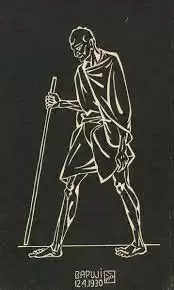
Mahatma Gandhi is widely recognized as one of the most remarkable freedom fighters in world history. However, only a few of us are aware that Bapu served as a muse to numerous contemporary artists in India and abroad. During Gandhi's lifetime, the renowned artist Nandalal Bose, associated with Shantiniketan, declared that Bapu served as an inspiration to all artists. One of his notable works, a linocut portrait titled 'Dandi March,' crafted in 1930, bears the inscription "Bapuji" and reflects Bose's deep reverence for Gandhi. This iconic artwork is permanently exhibited at the National Gallery of Modern Art in Delhi.
5. Mahishasura – Tyeb Mehta
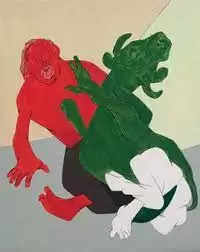
Mahishasura, a reinterpretation of the eponymous demon's tale, stands as the most significant creation by Tyeb Mehta, India's most prominent contemporary artist. This groundbreaking artwork holds the distinction of being the first Indian painting to surpass the million-dollar mark, achieving a staggering sale of $1.584 million at Christie's in 2005. The inspiration for this masterpiece stemmed from Mehta's visit to Shantiniketan, where the legend of Mahishasura left a profound impact on him. Mehta skillfully merges ancient imagery with a minimalist approach to form, color, and line, resulting in a remarkably modern composition brimming with vibrant energy and vitality.
6. Self-Portrait – Rabindranath Tagore
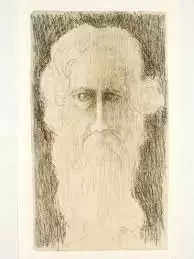
At the age of 63, Nobel laureate Rabindranath Tagore embarked on his journey as a painter in 1924. However, even long before this, signs of his artistic endeavors could be discerned through the various amendments and doodles found in his manuscripts. As Tagore neared the end of his illustrious career, his commitment to creating art that could be universally appreciated prompted him to engage in painting more consistently. He produced a multitude of sketches and drawings using brushes, pencils, and pens, with his self-portrait being among the most renowned. This particular artwork portrays the artist's full-face, bearded visage, enriched by its lack of color, unadorned backdrop, and the use of rudimentary pencil lines, giving it a primitive aesthetic.
7. Three Pujarins – Jamini Roy
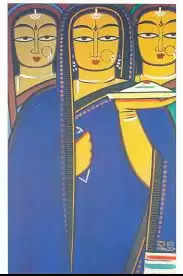
Jamini Roy, a distinguished Bengali artist recognized as one of the pioneers of early 20th-century Indian modernism, achieved a masterpiece with his painting titled "Three Pujarins," depicting three priestesses with almond-shaped eyes. Inspired by the folk art heritage of Bengal, Roy ventured into vibrant colors and forged his unique artistic style, giving birth to visually captivating artwork that delighted the viewer's senses.
8. Horses – M F Husain
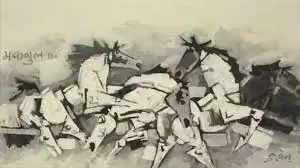
Throughout his painting journey, from its early stages until his demise, Maqbool Fida Husain, widely regarded as one of India's most prolific painters, took great pleasure in portraying the spirited and unrestrained essence of horses in numerous artworks. This masterpiece by the maestro skillfully captures the strength and dynamism of three horses through confident outlines that delineate these powerful creatures in full gallop. Recognized as one of Husain's finest creations and a prized possession for collectors, this painting was presented for auction at Christie's in 2008 and fetched a remarkable sum exceeding INR 1 crore.
9. Krishna (Spring in Kullu) – Nicholas Roerich
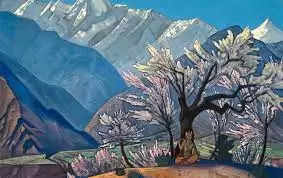
When discussing renowned Indian artworks, it would be remiss not to mention the notable creation titled "Krishna (Spring in Kullu)" by the esteemed Russian artist Nicholas Roerich. This painting, which is permanently exhibited at the Nicholas Roerich Museum in New York, portrays Krishna serenading with his flute beneath a blossoming tree, while majestic snow-covered mountains form a breathtaking backdrop. Roerich, having traversed the globe, eventually found his home in Kullu and passed away there. In 1979, the Archaeological Survey of India (ASI) recognized him as one of the nine artists whose works are deemed national art treasures.
10. Bindu – S H Raza

Syed Haider Raza, a legendary modern artist renowned for popularizing Indian iconography on a global scale, maintained an enduring fascination with the bindu and shunya (void), which became the focal points of energy in his artworks. Throughout his extensive and prolific career, which commenced with his inaugural solo exhibition in 1946, Raza's artistic expression underwent continuous evolution. However, it was in the 1970s that he discovered the motif that would elevate him to legendary status: the bindu. Raza eloquently expressed that the bindu represents a wellspring of energy and the origin of life, where life commences and expands into infinity. In addition to the bindu, his distinct and instantly recognizable geometric abstract works delved into themes such as prakriti (nature), kundalini (primal energy), and tribhuj (triangle).



